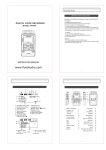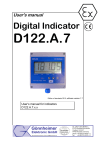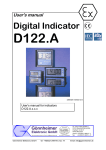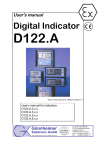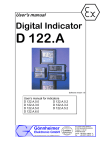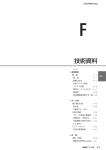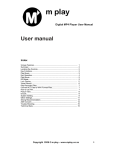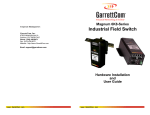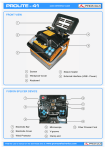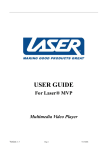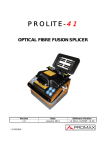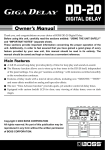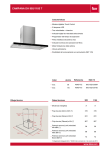Download GBMP 20Lbell prover &test bench
Transcript
GBPM-10 Gas Meter Error Test Bench (20L Bell Prover &Test Bench) (For Gas Meter Qmin Error calibration) User Manual -1- Contents Section One Outline…………………………………..……………(1) Section Two Working Principle………………..……………………(3) Section Three Main Technical Data…………..……...………………(5) Section Four Installation and Adjustment………………….………(6) Section Five Operation of Test Bench………………………………(8) Section Six Coefficient Calibration………………………………(15) Section Seven Test Method of Gas Meter…………….……………(16) Section Eight Service…………………………………...……....…(34) Section Nine Notice…………………………………...……....…..(38) -2- Section One Outline GBPM-10 Gas Meter Error Test Bench is especially in use for testing gas meter Qmin error, and widely applied to the gas meter produce factory, gas company and technical supervision department. The facilities have many advantages as follows: 1.It adopts ten gas meter to test at a time, in order to improve the test efficiency. 2.It adopts directional control valve to switch the airflow from right to left or left to right. 3.It adopts bar code scanner to scan the gas meter ex-factory serial number automatically. 4.It carries out the functions such as the automatic rise and fall of bell prover, the automatic switch on-off of air valve, the automatic leak hunting of the system before the test, the automatic switch on–off of flow point valve and so on, in order to relieve the work intensity and improve the test efficiency. -3- Flow Measurement and Calibration Section Two Working Principle Ⅰ. Shape Diagram (Figure 1) 1. Level Adjustment Bolt 13. Leader 2. Blower 14. Idler Pulley 3. Pressure Adjustment Weight 15. Bell Prover 4. Twine 16. Ruler 5. Compensative Weight 17. Magnifier 6. Compensative Wheel 18. Air Inlet Valve 7. Transmissive Wheel 19. Air Outlet Valve 8. Bearing Base 20. Pressure Testing Valve 9. Transmissive Gear 21. Water Tank 10. Rotary Encode 22. Liquid Outlet Valve 11. Beam 23. Ten position Qmin Test Bench 12. Guide Pole 3 2 0 1 9 8 7 1 23 1 11 6 8 6 1 71 5 1 4 1 1 5 4 3 9 1 2 1 0 2 2 2 2 1 (Figure 1) 4 Flow Measurement and Calibration Ⅱ. Working principle This Model LJQ bell prover standard facilities are composed of bell prover system and ten-positions Qmin test bench. The effective volume of the bell prover is used as the standard volume for calibrator, when the bell prover falls, the air within flow from the bell prove and through the link pipeline and tested meter to atmosphere. While the bell prover falling, the rotary encode that connects with the gear translates the volume of the bell prover into the pulse signal, and then the control system of the test-positions Qmin test bench turns the pulse signal into the volume of the bell prover. Consequently the essential error of the gas meter can be obtained by comparing the bell prover volume with the gas meter indicative volume. -5- Flow Measurement and Calibration Section Three Main Technical Data 1. Sealed liquid: Clear water or white oil. 2. Standard volume: 5 L, 10 L, 20 L, 50 L, 100 L, 200 L, 500 L, 1000 L, 2000 L. 3. Accuracy: ±0.2%,±0.5%. 4. Working pressure: 1Kpa(Adjustable). 5. Working pressure fluctuation: ≤20Pa, ≤50Pa. 6. Working power: 220VAC,50Hz. 7. Shape size of the bell prover: Length×Width×Height Weight(Filling up with water) (mm) (Kg) LJQ-20 LJQ-50 LJQ-100 LJQ-200 LJQ-500 LJQ-1000 550×400×1700 800×700×2300 1200×750×2950 1500×900×2950 1800×1250×2950 2000×1600×4500 70 250 500 1000 2000 3500 LJQ-2000 2500×2000×5800 7000 Model and Norms 8. Shape size of the test bench ( Length×Width×Height):2007×700×1875(mm) . -6- Flow Measurement and Calibration Section Four Installing and Adjusting Ⅰ.Installing Steps 1. Tight firmly the guide pole (13) to the edge of water tank (21) by the bolt. 2. Install wholly the beam (11) and the transmissive wheel (7) to two guide poles, and then screw the nuts on them firmly. 3. Connect one end of the twine (4) with the bell prover (15), joggle with the Transmissive wheel(7), and then connect the pressure adjustment weight (3) with the other end. Ⅱ. Adjusting Steps 1. Adjust the level adjustment bolt (1) of water tank, make parallel between the guide pole and twine. 2. Close the pressure testing valve (20), pour water or white oil into water tank until the ruler (16) of the bell prover goes up to 20cm. 3. Adjust the baffle-plate to turn off the photoswitch to the moment when the bell prover is locating at the topmost position (About 20cm on the ruler), turn off the up-photoelectric on-off, and darkle the light-panel, when the bell prover locates at the lowest position (About 98cm on the ruler), turn off the down-photoelectric on-off, and darkle the down-photoelectric on-off light. 4. Raise the bell prover, open the pressure testing valve (20), let the bell prover go down slowly, check whether the clearance between the idler pulley and the leader is suitable, if not, then adjust the idler pulley slip block again, make the bell prover going down smoothly, then test the fluctuation of working pressure, which should be≤50Pa(≤20Pa for the grade 0.2).5. Test the tightness: Raise the bell prover, stabilize for 10minutes, press 9/cal key to display nHb—A 00000. Then check the tightness, the count of the pulse should be less than 20 within 30 minutes, otherwise it’s leaky, please check the tightness of the test system. -7- Flow Measurement and Calibration Section Five Operation of Test Bench Key definition: 2/ns 5/δ 8 1/Q 4/δp,F 7 0/Test 3/δ1 6/△,K Par Set NO.Set Hand A Hand B · Qmax 0.2Qmax Qmin 9/Cal Air In Air Out Stop Reset Static/Clean Dis/Ent Electrify the calibrater or press Reset key after electrify the calibrater, the meter displays initially gAS- - tESt. Ⅰ. Set up the data 1. Set up the data not in common use (1) Press Par Set key, meter displays SEt, and then press Dis/Ent key, meter displays N-nO. ××××, means the tester number(Four digits are valid). Set up the tester number and press Dis/Ent key. (2) Meter displays CtL1—U ××××× , means the volume or pulse control value of the gas meter corresponding to Qmax key(When adopt the static method, the value is the volume control value of the bell prover ), after input the control value, press Dis/Ent key. (3) Meter displays CtL2—U ××××× , means the volume or pulse control value of the gas meter corresponding to 0.2Qmax key(When adopt the static method, the value is the volume control value of the bell prover ), after input the control value, press Dis/Ent key. (4) Meter displays CtL3—U ××××× , means the volume or pulse -8- Flow Measurement and Calibration control value of the gas meter corresponding to Qmin key(When adopt the static method, the value is the volume control value of the bell prover ), after input the control value, press Dis/Ent key. (5) Meter displays qH— ××××× ,means the maximum flow (m3/ h) of the gas meter ( Generally qH=2.5,4, 6 and 10), after input the value, press Dis/Ent key. (6) Meter displays PASS-, means the password, input 12345, press Dis/Ent key. * Use this password to login before setting up the following contents. (7) Meter displays tAbLE nO.××, means the table number (Two digits are valid). Set up the table number and press Dis/Ent key. (8) Meter displays bb— ×××××, means the meter coefficient of the gas meter( n/ L) The pulse that gas meter walks a turn (n) bb = —————————————————— The volume that gas meter walks a turn (L) (Generally, bb =0.1, if used to count the gas meter pulse, bb=1) After input the value, press Dis/Ent key. (9) Meter displays bc— ×××××, means the meter coefficient of the bell prover( n/ L) The accumulative pulse of the bell prover (n) bc = ———————————————————— The volume of the bell prover (L) After input the value, press Dis/Ent key. (10) Meter displays d10PA ××××× means the revised error of the channel A for the Qmax flow point(%),input the value and press Dis/Ent key. (11) Meter displays d10Pb ××××× means the revised error of the -9- Flow Measurement and Calibration channel B for the Qmax flow point(%), after input the value , press Dis/Ent key. (12) Meter displays d02PA ××××× means the revised error of the channel A for the 0.2Qmax flow point(%), after input the value , press Dis/Ent key. (13) Meter displays d02Pb ××××× means the revised error of the channel B for the 0.2Qmax flow point(%), after input the value , press Dis/Ent key. (14) Meter displays t1 × × × × × means the start-up delay time corresponding to Qmax flow point key. (15) Meter displays t2 × × × × × means the start-up delay time corresponding to 0.2Qmax flow point key. (16) Meter displays t3 × × × × × means the start-up delay time corresponding to Qmin flow point key. (17) Meter displays Cq-t1 ××××× means the air pressure balance time of the system before leak hunting. (18) Meter displays Cq-t2 ××××× means the leak hunting time of the system. (19) Meter displays good means the data not in common use has been set up completely. 2. Set up the meter number ××××× nA (1) Press No.Set key, meter displays ××××× ××× , means the ex-factory serial number of the gas meter tested in channel A (At most ten digits), it can be scanned from the bar code by scanner, or input it by the keyboard. - 10 - Flow Measurement and Calibration (2) Meter displays ××××× serial nb ××××× ××× , means the ex-factory number of the gas meter tested in channel B (At most ten digits), it can be scanned from the bar code by scanner, or input it by the keyboard. Ⅱ. Display again In order to check the set up data whether right or not, press Dis/Ent key, display again the data that already set up. Ⅲ. Display the tested value 1. Press 0/ Test key, display the volume of the bell prover and the tested meter at the same time. 2. Press 1/ Q key, display circularly q ××××× — means the moment flow ( m3/ h) qb ××××× — means the average moment flow ( m3/ h) Con-q 1.0-qH — means the tested flow point is Qmax Con-q 0.2-qH — means the tested flow point is 0.2Qmax Con-q 1-qL — means the tested flow point is Qmin 3. Press 2/ ns key, display circularly nHb—A ××××× — means the accumulative pulse of the bell prover in channel A nHb—B ××××× — means the accumulative pulse of the bell prover in channel B 4. Press 3/δ1 key, display - 11 - Flow Measurement and Calibration ××××× — means the essential error of the gas meter before revised (%) ××× — H — means the Qmax flow point n — means the 0.2Qmax flow point L — means the Qmin flow point 5. Press 4/δp, F , display circularly d10PA ××××× — means the revised error of Qmax flow point in channel A(%) d10Pb ××××× — means the revised error of Qmax flow point in channel B(%) d02PA ××××× — means the revised error of 0.2Qmax flow point in channel A(%) d02Pb ××××× — means the revised error of 0.2Qmax flow point in channel B(%) F ××××× — means the output frequency of the coder *δp — set up manually 6. Press 5/δkey, display ××××× — means the essential error of the gas meter after revised (%) ××× — H — means the Qmax flow point n — means the 0.2Qmax flow point L — means the Qmin flow point *δ = δ1-δp 7. Press 6/Δ, K key, display circularly ××××× - 12 - Flow Measurement and Calibration CFA — means the repeatability error of the tested flow point in channel A (%) ××××× CFB — means the repeatability error of the tested flow point in channel B (%) ××××× AC — means the meter coefficient of the gas meter in channel A ××××× BC — means the meter coefficient of the gas meter in channel B NOTE: The calculation of the repeatability error is selected by the two latest tested values under the same flow point. Ⅳ. Stop Press Stop key, stop all actions. Ⅴ. Clean While setting up the data, if the input data have mistakes, press the Static/Clean key, clean the input data, and input the right data again. - 13 - Flow Measurement and Calibration Section Six Coefficient Calibration Press 9/Cal key, meter displays nHb-A ×××××, the calibtater opens the testing pressure valve of the bell prover, starts to count, and takes the accumulative pulse that corresponding to the volume of the bell prover. Calculate the coefficient of the bell prover according to the meter coefficient calculation formula. The accumulative pulse of the bell prover (n) bc = ———————————————————— The volume of the bell prover (L) Section Seven Test Method of Gas Meter Test Manually (Static Method) 1.Read the initial value of the gas meter. 2.Press Static/Clean key, meter displays 0 0 0 0 0 ××× —H— means the Qmax flow point n— means the 0.2Qmax flow point L— means the Qmin flow point then press relative flow point key, the calibrater starts to measure the volume of the bell prover. When the bell prover reaches the control value, the calibrater closes the air out valve automatically. - 14 - Flow Measurement and Calibration Section Eight Service Diagnosis of and shooting at common troubles in bell prover Phenomenon One︰The Bell Prover is vibrating, making some metallic friction sound or blocked When the Bell Prover up and down. Solution : Step 1 : Check the clearance between the guide pole and Idler pulley, if too tight ,adjust it to suitable. Step 2 : Raise the Bell Prover to the top, observe the compensation rope and Bell Prover are whether in one parallel lines or not, if not, adjust the level adjustment bolts at the bottom of the Bell Prover. Phenomenon Two︰The system is leaking air when test the gas meter. Solution: Step 1: Check whether the gas meter is clamped tightly, if not, give an adjustment. Step 2: Raise the Bell Prover and keep it steady, observe the ruler mark after 10 mins. If the ruler mark come down above 2 millimeters under the constant circumstance in indoor temperature in 30 mins, the system is leaking. Step 3:The conjunction between air inlet valve and outlet valve should be checked if any case of leaking .Smear some soap water on the joint to see if there is any bubble gathered, if yes, reconnect. Phenomena Three︰Bell Prover could not be raised when testing over or pressing the "air in" button. Solution : Step 1 : Check whether the Pressure Testing Valve have been in a state of closure. Step 2 : Check whether the Blower is normal operation, whether the blower plugs is loose. Step 3 : Check whether the connecting between Bell Prover and blower are well connected. Phenomena Four︰Bell Prover can’t stop when it raise to the limited position, which leads to oil injection. NOTE︰Press the "reset" key to make the bell prover stop when oil injection is happening. If the "reset" key failure, please cut off the bench’s power supply immediately. Solution : Step 1 : Check whether the baffle-plate is cover over the photoelectric switch. - 15 - Flow Measurement and Calibration Step 2 : Open the Pressure Testing Valve, check whether the photoelectric switch is turned on when the Bell Prover fall from a height and the baffle-plate depart from the photoelectric switch. Step 3 : Check whether the connection between photoelectric switch and main control board are well connected. Phenomenon Five︰No encoding signal output when testing gas meter(not shown the total volume value of the Bell Prover). Solution : Step 1 : Check whether the gear link to the Rotary Encoder is loose. Step 2 : Check whether the connection between Rotary Encoder and Master Control Board are well connected. Diagnosis of and shooting at common troubles in test bench Phenomenon One︰The cylinder is leaking air when clamp the meter. solution : Checking whether the two nuts of the guide bar are at the same level. Phenomenon Two︰The gas meters are not run after changing the type of gas meter. Solution : Check whether the Directional Control Valves are stay at the right direction. Phenomenon Three︰Photoelectric Sampler is not stable when it falls down solution : Open the bench’s cover, infuse some lubricants to the Sliding bearings. Phenomenon Four︰The error value of the gas meter in the abnormality way all the time. solution : Inspect and check whether the parameter values are correct. If you come up against follow circumstances unfortunately, such as SCM lockup, no communications, no encoding count , etc. Do not open circuit boards for unauthorized repair or replacement, please notify to the manufacturer and technical staff immediately. We will give you a satisfactory answer as soon as possible. - 16 - Flow Measurement and Calibration Section Nine Notice 1. The facilities should be used in the constant temperature room. The temperature should be 20℃±5℃. The humidity should be 30 ~ 80% RH. 2. While working, the temperature difference amongst air within the bell prover, water (or white oil) inside the water tank and air inside the room should be ≤ 0.5℃~1.0℃. 3. Error calculation formula: V - Vs δ = ————— × 100% Vs Note: δ V —— the error of the gas meter —— the volume of the gas meter Vs —— the volume of the bell prover 4. Spread the insulative rubber on the working ground, and check the connection of the electric circuit wire before working. 5. Go up the bell prover, and turn off the power supply after working. 6. If the isolated liquid is water, wash the bell prover once per year. After installed, ask the Local Metrology Department to calibrate please! - 17 -

















